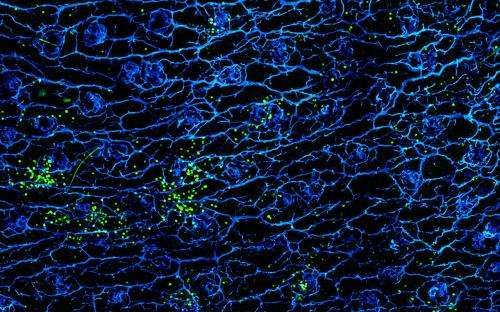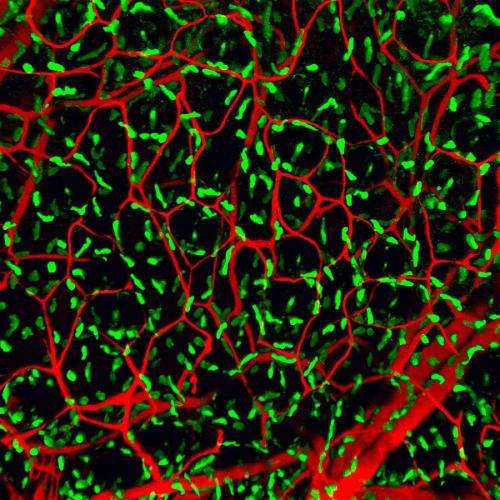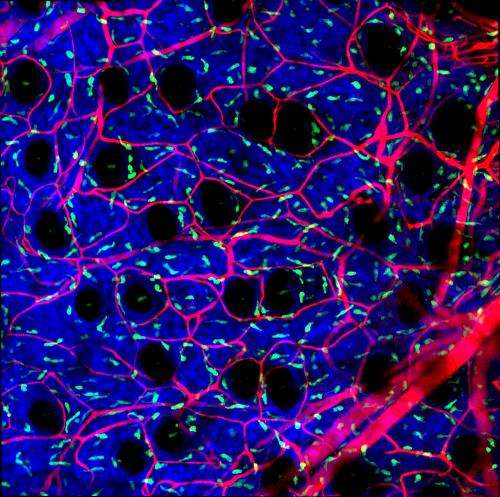Skin immune atlas, now available in 3D

Researchers at the Centenary Institute in Sydney have developed the first 3D model of the distribution of immune cells in living mammalian skin.
"It takes us from something like a paper map to Google Street View," says the study's lead author Dr Philip Tong.
"We knew all of these cells were there, but not how many of them and where. Now we can dive right in and we see that some types of immune cells are evenly distributed, while others clump in strategic locations."
The resulting 'Atlas', recently posted online by the highly ranked Journal of Investigative Dermatology, provides the basis for understanding an immune response at a particular site of the skin. It helps explain how the same challenge—for example, injecting the same vaccine or drug—to different areas of the skin can generate a different immune response.
The study found that some immune cells in mice skin, such as the infection-detecting dendritic cells, are evenly distributed throughout the skin, while others, such as the inflammatory mast cells, only occur at certain depths or regions where they can have most impact—in this case close to blood vessels. In mice, there were more of the immune system foot soldiers known as T cells in the skin on the back than in the other areas.

Also, the proportions of the different types of immune cells changed over time. A surprise finding is that in older mice, for instance, displayed greater numbers of the first-strike gamma-delta T cells whilst as expected alpha-beta T cells were increased which contain the cells involved in recognising past infections.
While the study was not geared to interpret human disease, it should allow a better understanding of what goes on in the mouse models used to study disease mechanisms. "This is a baseline study. But it has wide implications for any study involving the immune response of skin," says Dr Tong.
The work could also open the way to a similar 'maps' of the human immune system, allowing finer diagnosis and better targeted treatments for skin infections.
The next step, Dr Tong says, will be to expand the work to human skin, and also to incorporate further features, such as nerves and the drainage or lymphatic system.

Tong is a dermatologist in training and undertaking his PhD at the Centenary Institute as the Dean's Fellow in Dermatology at the University of Sydney Medical School. He is supervised by the papers' senior author and Head of Centenary's Immune Imaging Research Group, Professor Wolfgang Weninger. They worked on the project with colleagues at the University of Sydney, the Royal Prince Alfred Hospital and the University of South Australia.
The researchers exploited a technology known as intravital multiphoton microscopy, which allows monitoring of immune cells at different depths in living tissue. They also used transgenic mice with fluorescently-labelled immune cells of different colours so they could be picked out by the microscope. This allowed the team to survey the deployment of the immune cells in four areas of skin—on the ear, the tail, the back and the footpad—in mice of different ages. The microscope observations were combined with information on the numbers of each type of immune cell encountered using a technology called flow cytometry.
"This study shows the enormous value of Centenary's research and its close links both with Sydney University and the Royal Alfred Hospital," the Institute's Executive Director, Professor Mathew Vadas AO says. "Dr Tong is one of a group of young clinician researchers who can see the potential for their studies to assist in the clinic and drive them towards improving patient care in dermatology."
More information: "The Skin Immune Atlas: Three-Dimensional Analysis of Cutaneous Leukocyte Subsets by in vivo Microscopy." Tong PL, et al. J Invest Dermatol. 2014 Jul 9. DOI: 10.1038/jid.2014.289. [Epub ahead of print]

















